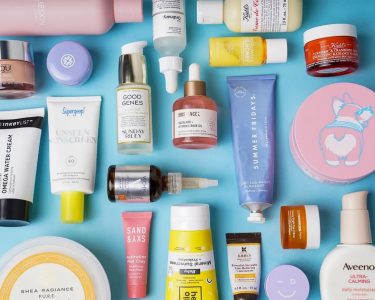Looking for a way to upgrade your makeup routine? Unfortunately, not all cosmetics are created equal. In fact, some may be causing sneezing fits and other allergic reactions. But don’t worry! With the right knowledge and approach, you can determine if your makeup is making you sneeze and take steps to avoid further discomfort. Read on to learn more about identifying makeup allergies and how to keep them at bay.
What is a makeup allergy?
A makeup allergy is a type of contact dermatitis that occurs when your skin comes in direct contact with an allergen found in cosmetics. This can cause various symptoms, ranging from mild to severe, and can affect anyone at any age.
The most common allergic reactions to makeup include redness, itching, swelling, hives, blisters or even scaly patches on the face and around the eyes. In more serious cases, individuals may experience difficulty breathing or swallowing.
It’s important to note that not all adverse reactions to makeup are caused by allergies. Others may be due to irritation from harsh chemicals or poor product quality. However, if your symptoms occur consistently after using certain types of products and subside once you stop using them, it’s likely that you have a makeup allergy.
If left untreated, a makeup allergy can worsen over time and lead to chronic eczema-like rashes on the face. Therefore it’s important for anyone experiencing these symptoms regularly to consult with their doctor or dermatologist for proper diagnosis and treatment options.
How do you know if you have a makeup allergy?
Having a makeup allergy can be frustrating and uncomfortable. But how do you know if you have one? The symptoms of a makeup allergy can vary from person to person, but some common signs include redness, itching, swelling, and even hives.
One way to determine if you have a makeup allergy is by taking note of when the symptoms occur. Do they appear shortly after applying your makeup or while wearing it throughout the day? If so, it’s possible that one of the ingredients in your cosmetics is causing an allergic reaction.
Another way to identify a potential makeup allergen is by conducting patch tests on different areas of your skin with small amounts of each product. This will help narrow down which specific ingredient(s) may be causing the allergic reaction.
It’s important to seek medical advice if you suspect that you have a makeup allergy. A dermatologist can perform more comprehensive testing and provide recommendations for alternative products that are less likely to cause an allergic reaction.
Remember: prevention is key when it comes to avoiding allergies caused by cosmetics. Always read labels carefully and research any unfamiliar ingredients before using them on your skin.
What are the symptoms of a makeup allergy?
Makeup allergies can manifest in different ways, and symptoms may vary from person to person. Some of the most common signs of a makeup allergy include redness, itching, burning sensation on the skin, swelling, and bumps or blisters.
If you experience these symptoms after using a new product or even an old one that you’ve been using for some time, it’s best to stop immediately and seek medical attention if needed. The severity of the reaction can range from mild irritation to severe inflammation that requires urgent treatment.
In addition to physical symptoms on the skin surface, some people may also experience respiratory issues like sneezing or difficulty breathing when exposed to certain products. This can be particularly problematic if you’re applying makeup near your nose or mouth.
What’s more concerning is that sometimes allergic reactions can lead to secondary infections such as impetigo (a bacterial infection) which is characterized by oozing sores filled with pus.
It’s important to remember that not all reactions are caused by “allergies.” Sometimes irritants like fragrances or preservatives found in cosmetics can cause similar adverse effects on the skin without being true allergens.
Knowing what kind of reactions your body has when exposed to various types and brands of makeup products will help prevent future incidents.
What are the most common makeup allergens?
When it comes to makeup allergies, there are several common allergens that can trigger a reaction. One of the most popular culprits is fragrance. Many cosmetics contain fragrances that can cause skin irritation and sensitivity in those who are allergic.
Another common allergen is preservatives, such as parabens. These ingredients help prevent bacteria growth in cosmetics, but they can also cause an allergic reaction in some people.
Emollients like lanolin and mineral oil are also known for causing makeup allergies. They help make your skin feel soft and smooth, but they can sometimes clog pores and lead to breakouts or rashes.
Formaldehyde releasers like quaternium-15 or imidazolidinyl urea are often found in nail polish or other beauty products with a long shelf life. Although these chemicals help keep the product from spoiling, they can irritate sensitive skin.
Some colorants used in makeup products may trigger an allergy too. For instance, red dyes commonly found in lipsticks have been known to cause reactions in people with sensitive skin.
It’s essential to read labels carefully when selecting cosmetic products if you’re prone to allergies since many contain one or multiple of these common allergens.
How can you avoid a makeup allergy?
Avoiding a makeup allergy can be tricky, especially if you’re not sure what ingredients trigger your reaction. One way to prevent an allergic reaction is by avoiding products that contain common allergens such as fragrance, preservatives like parabens and formaldehyde-releasing agents, and certain types of dyes.
To further protect yourself from potential irritants, it’s important to read product labels carefully before purchasing any cosmetics items. Whenever possible, choose products with fewer ingredients or look for those specifically formulated for sensitive skin types.
Another way to avoid a makeup allergy is by doing patch tests before using new products on your face. This involves applying a small amount of the product on the inside of your wrist or behind your ear and waiting 24 hours to see if any adverse reactions occur.
If you do have a known sensitivity or allergy to certain ingredients, consider seeking out hypoallergenic brands or consulting with an allergist before trying new beauty products. They may be able to recommend specific formulations tailored towards people with allergies.
By taking these precautions and being mindful of the ingredients in your makeup routine, you can help reduce your risk of experiencing an allergic reaction while still enjoying all the benefits that cosmetics have to offer.
Conclusion
It’s important to remember that a makeup allergy is not uncommon and can affect anyone at any time. By knowing the symptoms and common allergens, you can take steps to avoid an allergic reaction from your cosmetics. If you suspect that you have a makeup allergy, consult with your dermatologist or allergist for further testing and advice on how to manage your symptoms. With a little bit of research and precautionary measures, you can enjoy beautiful makeup without the sneezing!




